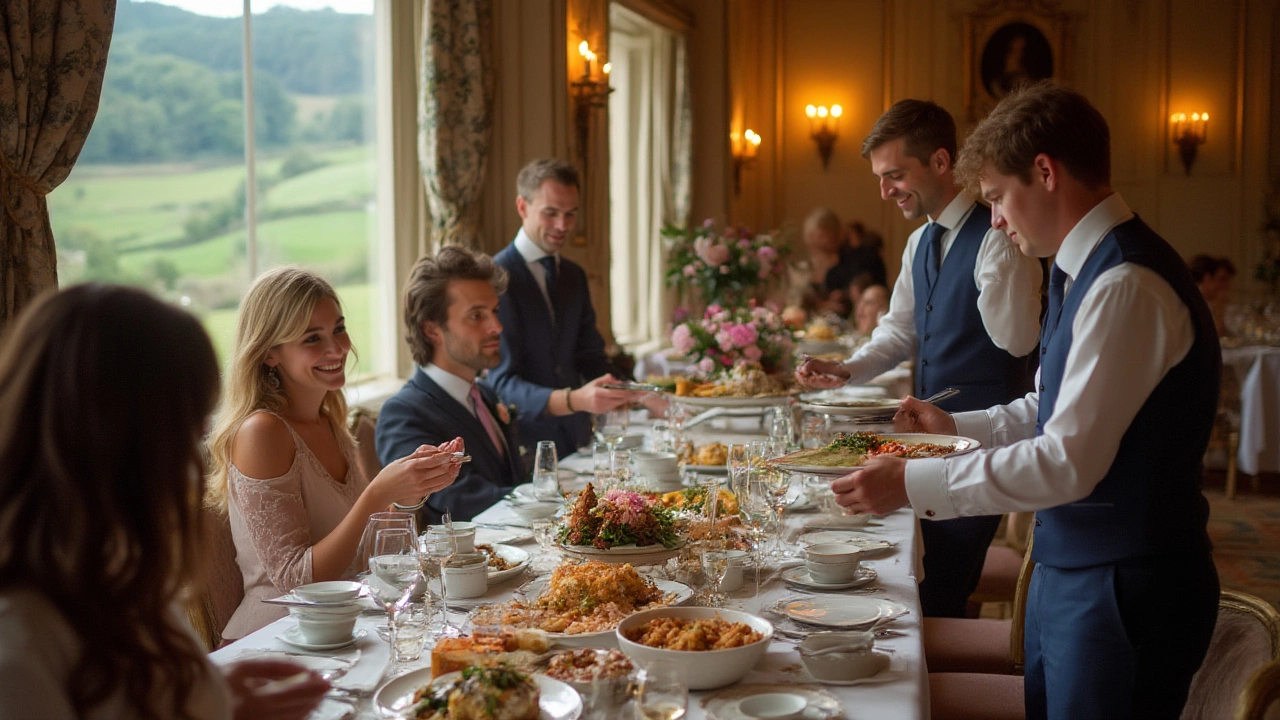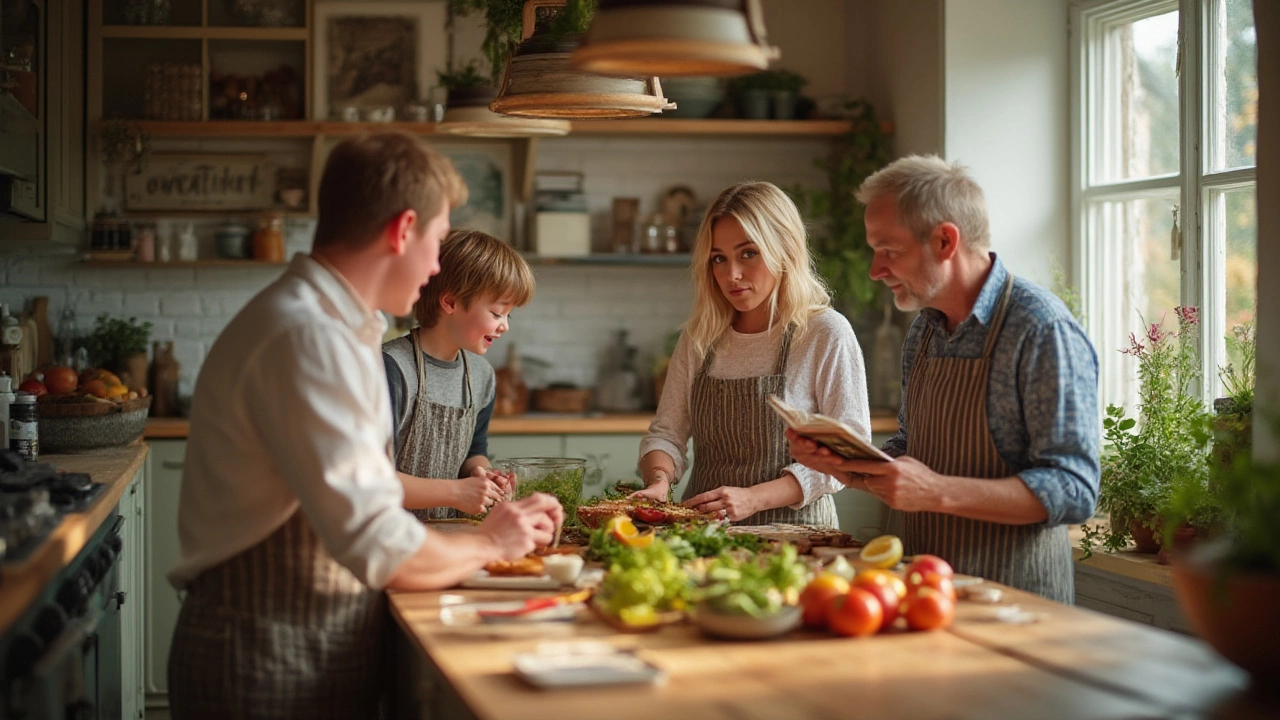You book a holiday home and scroll down to see the words "catering" and "self-catering." Or maybe you’re planning an event and someone tosses those options at you like you’re supposed to just know. The truth? Most people honestly have no idea what separates the two—or what each actually feels like in real life. Here’s the deal: catering and self-catering aren’t just fancier or cheaper versions of getting fed. They’re two totally different worlds when it comes to planning, cost, effort, and, let’s be honest, fun. Stick around and you’ll find out which one actually suits your lifestyle (and your wallet).
What Is Catering? Inside the World of Full-Service Food
Catering means someone does all the food work for you. Think of it as the "hands-off, enjoy-every-bite" approach. It’s what you get at big weddings, those power-lunch meetings, and even fancy hotel stays offering full board. A team of professionals cooks, sets up, and serves every meal or snack. You show up and just eat—no shopping, cooking, serving, or cleaning. If I had catering at home, my dog Max might actually get gourmet dog treats delivered by a guy in a suit.
The big pro? Zero food stress. Seriously, you don’t even choose what pan to use. You pick your menu in advance, or sometimes just trust the chef's specials. Since everything’s handled, you can focus on friends, business, or pure relaxation. Need a vegan gluten-free buffet, cocktails for fifty, or a kid-friendly cake? Tell your caterer, and magic happens.
Catering comes in levels. There’s drop-off (food arrives in trays, maybe disposable cutlery—done!), buffet-style (set it up yourself), or full service (staff will plate and pour). Big events with over 100 guests almost always use catering for sanity’s sake. According to a 2024 study by Statista, the global catering market hit $535 billion, showing just how vital these services are for events large and small.
The catch? Expect to pay for the privilege. Catered meals can cost twice or even three times more than home-cooked options, depending on your menu and region. For events, you’ll see prices from $25 to $150 per person, not even counting extras like drinks or tableware. But it’s not just about money—catering lets you actually be present at your own celebration or meeting, instead of running back and forth between the kitchen and the chaos. For some, that’s priceless.
Quick tips for using catering:
- Always taste-test if you can.
- Read reviews on freshness, punctuality, and flexibility (especially with allergies).
- Book early—some caterers get booked out months ahead for weddings and holidays.
- Clarify clean-up duties. Some include it, some don’t.
So, catering is your golden ticket when you just want to eat, chat, and relax—or if you’ve got a crowd. Next up: what if you’re the sort who loves to take the culinary wheel?
What Is Self-Catering? The DIY Food Route Explained
Now, if catering is all pampering, self-catering is about taking charge. With self-catering, you stay somewhere with kitchen gear (even if it’s basic), shop for your own ingredients, and cook your own food, your way, on your own schedule. No chef, no servers—just you and a fridge full of groceries. Forget fancy silver trays; think local markets, family recipes, and eating dinner in pajama pants if you want.
This isn’t just about holidays. Backpackers do it in hostel kitchens. Families opt for self-catering villas at Disney resorts to save cash and customize their meals. Event hosts might book a rustic barn with a kitchen and do a team cook-off—hugely popular these days because it turns food prep into fun.
The huge perk? Budget control. Cooking your own meals on holiday can cut costs in half or more. For context, a 2023 report from VisitBritain showed that self-catering UK holidays averaged £150 less per week than fully catered breaks. You also get total flexibility with timing and taste. Want eggs at midnight? Go for it. Gluten-free or vegan? No special requests needed—you’re the chef now.
Here’s what you’ll need to consider with self-catering:
- You buy the food and usually all the basics (oil, salt, coffee).
- Check what’s stocked: Are sharp knives, a kettle, or a corkscrew included? Sometimes, it’s just one dodgy frying pan—ask ahead.
- You’re responsible for tidying up. Forget leaving dirty dishes “for the staff”—you are the staff.
- Meal planning becomes your new superpower. Create a loose plan before you arrive so you don’t waste half the trip at the supermarket.
Some people get hooked on the cozy community vibes of shared cooking or the creative freedom of choosing wild local ingredients. But if you hate cooking or think cleaning up is a deal-breaker, self-catering might sap your holiday spirit. Still, with today’s popularity of foodie travel and personalized diets, self-catering keeps rising, especially for families, long stays, and big groups.
Here’s a quick breakdown:
| Feature | Catering | Self-Catering |
|---|---|---|
| Food Prep | Handled by professionals | Done by guests or hosts |
| Cost | Higher (service + food) | Lower (ingredients only) |
| Flexibility | Limited to set menus/times | Total control |
| Clean-up | Usually included | DIY |
| Personalization | Special requests possible | Unlimited |
If you want sunrises over toast on a balcony or barbecues with friends where everyone chips in, self-catering is the ticket.

The Big Decider: When Should You Pick Catering or Self-Catering?
Maybe you’re torn. Both options suit different moods and moments. Here’s my honest take. If you want pure relaxation or you’re handling anything for a large, mixed group (think: two dozen relatives with wildly different tastes), catering saves stress. It’s a must for milestone parties, business events, or holidays where you don’t want to lift a finger. High-end resorts, cruise ships, and destination weddings? Usually, catering is baked in because it guarantees smooth sailing.
Maybe your style is more go-with-the-flow. Self-catering is your friend when you crave freedom or have food allergies, strict diets, or just a yen for trying that weird local cheese. Larger families or groups often find that splitting grocery costs saves a ton—plus, picky eaters can always make their safe favourites. It’s also awesome for longer stays when eating restaurant meals every night would make your wallet and waistline groan. New parents? Having a full kitchen trumps asking for another bottle-warmer at 2 a.m.
When picking, ask yourself:
- How much cooking do I enjoy, really?
- How important are meal times and variety?
- What’s the group size and vibe?
- What’s the actual cost per person, per day, both ways?
- How much time am I willing to spend on groceries and dishes on holiday?
Don’t forget location. In some destinations, like rural parts of Scotland or tiny Greek islands, you may have limited restaurant choices or high prices, so self-catering becomes the smart (sometimes the only) move. In buzzing cities or all-inclusive resorts, catering rules—unless you love midnight snacks or want to host your own wine and cheese night without a curfew.
A good tip: Try a mix. Lots of places let you add breakfast catering but cook dinner yourself. Or start with catering for the first two nights, then go self-catered as you settle in. This hybrid plan lets you hit the ground running but still taste the local flavour on your own schedule.
Things Nobody Tells You: Surprising Facts and Handy Tips
There are tricks the travel agencies and event planners won’t always share. When it comes to catering, always double-check portions. Some providers skimp unless you specify "generous servings." If you have leftovers from a catered meal, ask about taking them home—rules vary hugely by country, but no sense leaving paid-for food behind if you can help it.
During big events, don’t underestimate kids’ appetites. The under-10 crowd can sometimes out-eat adults, especially if the dessert tray comes around early. With self-catering, factor in downtime for shopping and prep. Local markets close shockingly early in some places: France, Italy, Spain—sometimes you wander in at noon and find only empty boxes and a grumpy baker.
Hidden bonus: Self-catering lets you try kitchen gadgets you might not own at home. Ever cooked fish caught that morning with a touristy hotplate? It’s a blast. Or mess up a recipe and order pizza—nobody’s grading your performance. Take it from a guy who once mistook salt for sugar making pancakes in an Edinburgh Airbnb (Max still sniffed around hopefully; he’ll eat anything).
If you’re heading abroad, bring a couple of essentials like sharp knives or that special coffee you like—sometimes what you find in your rental is more “grandma’s forgotten collection” than useful tools. Many people pack a collapsible cooler bag for picnic days, letting you go full local and eat in wild, memorable places instead of just sitting at a table every time.
For those who want the best of both worlds, some destinations now specialize in part-catered holiday homes. They’ll stock you with a breakfast basket or arrange chef "experiences" for one or two special nights. This trend is big in Tuscany, southern France, and even parts of the U.S.—a happy middle ground that keeps things special without requiring a big spend on every meal.
Bottom line, your choice—catering or self-catering—shapes more than just what’s on your plate. It changes how you spend your time, how much you spend, and what memories you take away. Whether you’re hosting a wedding or eating pasta out of the pot as the sun sets on your back porch, there’s no wrong answer. Just don’t forget the dog treats—trust me, you’ll have earned them, no matter what route you pick.

